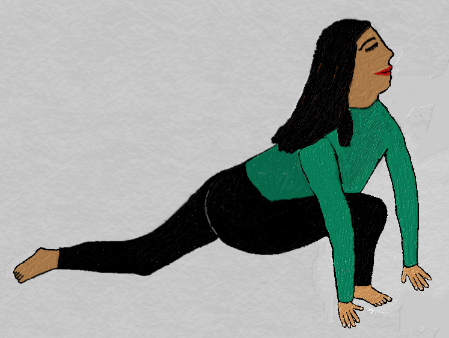|
2017 is off to a wonderful beginning. Looking forward to continuing with the posts. As always, suggestions are welcome. Lets get on with the Surya namaskar.
The ninth posture (the left leg is in front and right leg behind) in Surya namaskar is similar to the fourth, (the right leg is in front and the left leg is behind), that is the equestrian posture. This is also called the ashwa sanchalanasana. • Posture: From the parvatasana or mountain pose, bring the left foot forward, between the hands with the left hip and knee bent as in lunge position. Extend the right leg back and plantar flex the right foot, so that the foot rests on the dorsum or top of foot (in the fourth posture, the right foot is up front and the left foot behind). Deepen the lunge and to enhance stretch in right groin this time, arch the back, while flexing the left hip as far as possible. Here the transition movement from the eighth to ninth posture is not as big as from the third to fourth and hence is relatively easier to achieve, gracefully. • Muscles: As you lower to the floor by bending (flexing) the left leg at the hip and knee joints, the psoas, pectineus, and hip flexor synergists as well as adductors and gluteus medius /TFL (medio-lateral stability) contract to keep the bending leg knee in line with the toes. The hamstrings contract at the left knee and dorsiflexors of the foot provide continued forward flexion of the knee and ankle joints. As always, the trunk stabilizers (transverse abdominus and multifidi) keep the spine neutral during the move. The extensor muscles of the right hip- the gluteus maximus, long head of biceps femoris, and the semimembranosus and semitendinosus- work in synchrony. The quadriceps extend the right knee and the plantar flexors (gastroc-soleus) contracts so the dorsum of foot comes in contact with the ground. If the pose is further deepened through trunk extension, the erector spinae contracts, and the latissimus and lower trapezius helps depress the shoulder blades with the palms open and hands firmly on floor. • Breathing: During the transition of posture from parvatasana to ashwa sanchalanasana, breathe in deep and long, even when you arch your back. This posture contains breathing in and out. In the final posture, chest is pushed out, arching the back, and so the anterior lobes of the lungs fill up with air in the alveoli for gaseous exchange. Breathe out as you hold the pose or transition to next posture. “Om Adityaya Namaha” “I bow to thee, who is God of gods.”
0 Comments
Your comment will be posted after it is approved.
Leave a Reply. |
Details
AuthorAmi Gandhi is a licensed physical therapist in the state of California. She is the owner of StableMovement Physical Therapy, a small boutique practice in San Jose that offers patient centered, one-on-one, hands-on physical therapy. Archives
March 2018
Categories |
